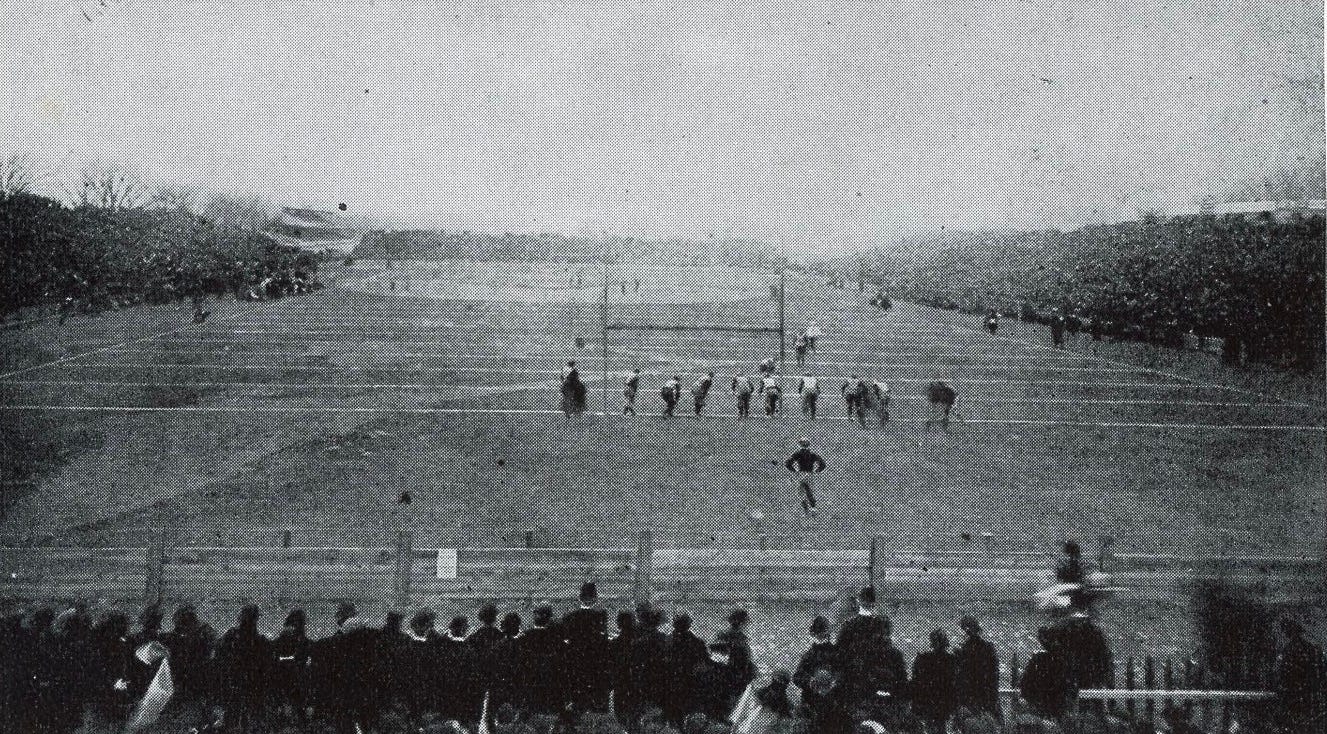Today's Tidbit... 1876 IFA Rule #47: Try At Goal Spot
This is #47 in a series covering football's original 61 rules adopted by the Intercollegiate Football Association in 1876. We review one rule each Friday.
Rule 47 is among those that best reminds us of football's rugby origins because the rule lives on largely untouched in rugby today, while it is long gone in football. Back in 1876, neither rugby nor football awarded points for a try; that is, touching the ball down behind the opponent's goal line. (Rule 9 renamed the try and called it a touchdown, but the "try" lingers on Rule 47.) Despite the name change, the team earning the try gained an opportunity for a free kick at goal. Here's how it worked:
Rule 47: If a try at goal be made by a place kick, a player of the side which has touched the ball down shall bring it up to the goal-line (subject to Rule 48) in a straight line from, and opposite to, the spot where the ball was touched down, and there make a mark on the goal-line and thence walk straight out with it at right angles to the goal-line, to such distance as he thinks proper, and there place it for another of his side to kick. The kicker's side must be behind the ball when it is kicked and the opposite side must remain behind their goal-line until the ball has been placed on the ground. (See Rules 54 and 55.)
So, the team earning the try walked the ball their chosen distance at a right angle from where it crossed the goal line. From there, they could attempt a free kick. As you can see when watching the Rugby World Cup, which starts today, the relevant rugby rule changed later, so they walked the ball out from where they touched it down, not where it crossed the goal line. That is why rugby players sometimes run behind the goal posts after scoring the try.

Football retained this rule for the try at goal, aka goal from touchdown, aka extra point, until 1920. At that point, the team scoring the touchdown could attempt a free kick from the spot on the field of their choice. (The puntout went away in 1920 as well.) That changed in 1922 when the scoring team received the ball at the 5-yard line with the option to run or pass the ball over the goal line or attempt a contested kick, with each option worth one point. The two-point option for running and passing entered the game in 1958.
Click the appropriate link for previous stories in the series:
Intro | #1 Drop Kick | #2 Place Kick | #3 Punt | #4 Goal Posts | #5 Goal | #6 Goal ≠ Punt | #7 Scoring | #8 Dead Ball | #9 Touchdown | #10 Tackle | #11 Scrimmage | #12 Ball Handling | #13 Dead Ball | #14 Scrimmage Ball Handling | #15 Run In | #16 Goal Line | #17 Boundary Lines | #18 Crying “Down” | #19 Maul In | #20 Maul in Pax | #21 Touch-in Goal | #22 Onside | #23 Offside | #24 Return to Onside | #25 Defensive Offside | #26 Throwing Back | #27 Knocking On | #28 Fair Catch | #29 Punt-out | #30 Punt-On | #31 Into Touch | #32 Inbounding | #33 Pushed Into Touch | #34 Right Angle Throw Out | #35 No Fair Catch | #36 Kickoff | #37 Kickoff Timing | #38 Change Goals | #39 Toss Up | #40 Loser Kicks | #41 Kickout | #42 Kickout Procedure | #43 Fair Catch Free Kick | #44 Free Kick Location | #45 Own Goal Touch Down | #46 Try At Goal
Football Archaeology is reader-supported. Click here to buy one of my books or otherwise support the site.



